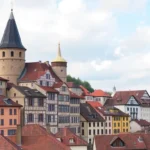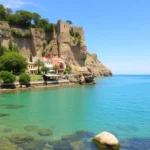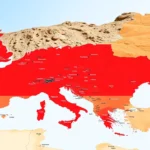30 Fascinating Facts About Spain and Spaniards You Might Not Know

Spain is often seen as a land of vibrant traditions, rich history, and unique quirks that make it stand out in the global arena. If you think you know everything about Spain and its people, think again! Here are 30 fascinating curiosities about Spain and the Spaniards that might surprise you.
Curiosities that make Spain unique
1. Spain ranks as the third country in the world with the most UNESCO World Heritage Sites, boasting a total of 47. Among these, the Sagrada Familia in Barcelona and the Alhambra in Granada are the most visited. You can find the complete list here.
2. The flamenco, a world-renowned symbol of Spain, has a somewhat mysterious origin. The most accepted theory suggests it emerged in Andalusia, influenced by a rich tapestry of cultures including Gypsies, Arabs, Jews, and native Andalusians.
3. While Spaniards often eat later than their European neighbors, lunchtime is usually between 1 PM and 3 PM here. In many other countries, lunch is typically served around 12 PM. Dinner follows suit, with many European countries dining around 7 PM. Speaking of food, check out the traditional dishes to try in Spain.
4. Spain is the second country in the world with the most vineyards, which explains why wine is a staple of life here! The tradition of going out for a drink is deeply embedded in Spanish culture, making it the country with the highest number of bars per capita, closely followed by Cyprus. The city of León is particularly noted for this.
Daily Life and Culture in Spain
5. The infamous siesta is often associated with Spanish culture, but approximately 60% of Spaniards typically do not take one. The term itself refers to the sixth hour of the day, which for the Romans was noon, a perfect time for a short nap after lunch.
6. The original Valencia is known for its paella and Fallas festival, but interestingly, there are over 40 places named "Valencia" worldwide, a nod to the colonial era when explorers named new territories after their hometowns.
7. Colonialism also spread the Spanish language, which is now spoken by approximately 400 million people across 20 countries.
8. Spain is home to several co-official languages, including Catalan, Valencian, Galician, Aranese, and Basque. The latter is particularly intriguing due to its ancient roots and lack of a definitive origin theory. When I first heard a song in Basque, I thought it was Japanese!
Myths and Legends
9. There’s a popular myth that Walt Disney was born in Mojácar, a beautiful town in the province of Almería. While this seems to be just a legend, it adds to the charm of the area.
10. Tapas are a national pride, but their name's origin is debated. One of the most convincing theories suggests they were originally slices of bread or cured meat used to cover drinks, keeping flies and bugs at bay.
Remarkable Records and Achievements
11. Spain boasts the highest organ donation rate in the world, leading this field for over 20 years!
12. In Madrid, you will find the world’s oldest restaurant, Restaurante Botín, which opened its doors in 1725. Remarkably, it has remained operational every day since, even during the Civil War.
13. Cádiz is known as the oldest continuously inhabited city in Europe, founded by the Phoenicians around 1100 BC.
Quirky Facts about Spain
14. The longest word in the Spanish language has 23 letters and is electroencefalografista.
15. Instead of a magical fairy, children in Spain receive a visit from the Ratón Pérez when they lose a tooth! This character was created by Luis Coloma for a story he wrote for young Alfonso XII in 1894.
16. Spain is not just the birthplace of the mop and the lollipop; it has also given the world several remarkable inventions, including the submarine, the Spanish guitar, epidural anesthesia, the digital calculator, and even mayonnaise!
Language and Culture
17. The exclamation “Olé”, commonly used to cheer, has an uncertain origin, but many etymologists believe it derives from the word “Allah.” Numerous words in Spanish have Arabic roots due to the country’s historical connections, such as ojalá (inshallah), aceite (azzáyt), taza (tassa), azúcar (assukkar), alcalde (alqádi), and guitarra (qitarah).
18. The Spanish Flu pandemic of 1918 was misnamed; it did not originate in Spain. The name arose because Spain was the first country to report on the outbreak.
19. Among the ten most expensive paintings ever sold, three were created by the renowned artist Pablo Picasso: “Les Femmes d'Alger,” “Le Rêve,” and “Nude, Green Leaves and Bust.” More information can be found here.
20. The tradition of eating 12 grapes on New Year's Eve started in 1909, symbolizing good luck for each month of the coming year. The practice came about due to a surplus grape harvest that year.
Geographical Wonders and Unique Traditions
21. Spain is home to the only desert in all of Europe, the Tabernas Desert in Almería, famous for being the filming location of many Spaghetti Westerns.
22. Spain hosts numerous quirky festivals, from the famous La Tomatina to Las Fallas. One of the strangest is the Romería de Santa María de Ribarteme, which features a parade of coffins with “living dead” participants, where those who survived near-death experiences seek blessings.
23. The famous creator of “Don Quixote,” considered the first modern novel, Miguel de Cervantes, was known as “The Lame of Lepanto” after losing mobility in his left hand from a gunshot wound during the Battle of Lepanto.
Historical Timeframes and Political Facts
24. Interestingly, Spain should technically follow the UTC±0:00 timezone since the Greenwich Meridian runs through it. However, during World War II, Francisco Franco adopted Central European Time, aligning Spain with Nazi Germany. You can read more about this intriguing history here.
25. Spain has two islands with particularly interesting histories. The Isle of the Faisans is jointly ruled by France and Spain, alternating sovereignty every six months. In contrast, the Isle of Perejil was the center of a bizarre political-military crisis between Spain and Morocco in 2002.
26. In 2005, Spain became the third country to legalize same-sex marriage, a significant step for LGBTQ+ rights globally.
27. The Romans believed Finisterre was the end of the world, which aligns with some modern flat-earth theories… just kidding (or maybe not).
28. Not only does Spain produce the world's highest quality olive oil (liquid gold), but it also accounts for nearly half of global production. Other notable products include Canary bananas, the only European-grown bananas, and saffron (red gold), of which Spain is the second-largest producer worldwide, following Iran.
29. Tourism is a critical revenue stream for Spain, making it the second most visited country in the world in 2019, just behind France.
30. The Camino de Santiago is arguably the most famous pilgrimage route, with its symbol being the scallop shell. This shell was given to pilgrims who had visited the tomb of Apostle Santiago and were returning home (yes, they walked back!).
And there you have it, 30 curiosities about Spain and Spaniards. Whether you're a local or just an admirer, we hope you've discovered something new!
| Save on your trip |
| Compare and find cheap flights here |
| Find accommodations at the best prices here |
| Book activities and excursions in Spanish here |
| Get a 5% discount on your IATI travel insurance here |
| Book airport transfers here |
| Get a gift of €10 booking transportation across Europe here |
| Find out how to withdraw money without fees here |
| Get a 5% discount on your eSIM from Holafly here |
| Rent a car with the best deals here |
| Compare prices for van rentals here |
| The best books and travel guides here |
| All our articles about Spain |





Deja una respuesta